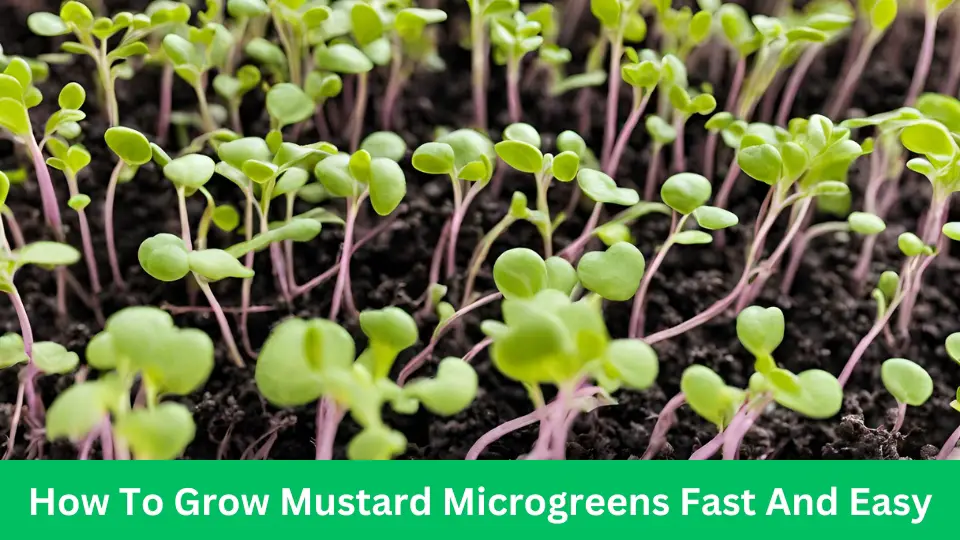To grow mustard microgreens fast and easily, provide adequate sunlight, water them regularly, and maintain a consistent temperature. With these steps, you can enjoy a bountiful harvest of delicious mustard microgreens in no time.
Growing mustard microgreens at home is a quick, easy, and rewarding way to add fresh and nutritious greens to your diet. Whether you have limited space or a green thumb, mustard microgreens are a great option, requiring minimal time, effort, and resources.
These tiny greens contain vitamins, minerals, and antioxidants, offering flavor and health benefits. This guide will walk you through the steps to grow mustard microgreens fast and easily. By following these simple instructions, you can have a continuous supply of nutrient-rich microgreens ready to add vibrancy to your salads, sandwiches, and other dishes.
Benefits Of Growing Mustard Microgreens
Discover the numerous benefits of growing mustard microgreens, from their fast and easy cultivation process to their high nutritional value. Boost your health with these nutrient-rich greens in just a few simple steps.
Nutritional Value And Health Benefits
Mustard microgreens are flavorful and packed with essential nutrients, making them a valuable addition to your diet. These tiny greens are loaded with important vitamins and minerals, such as vitamins A, C, and K, as well as folate, potassium, and iron. Incorporating mustard microgreens into your meals can boost your immune system, support healthy digestion, and promote overall well-being.
What sets mustard microgreens apart is their unique combination of health-promoting properties. They are rich in antioxidants, which combat free radical damage, reducing the risk of chronic diseases such as cancer and heart disease. Additionally, the glucosinolates in mustard microgreens provide a powerful anti-inflammatory effect, supporting joint health and reducing inflammation throughout the body.
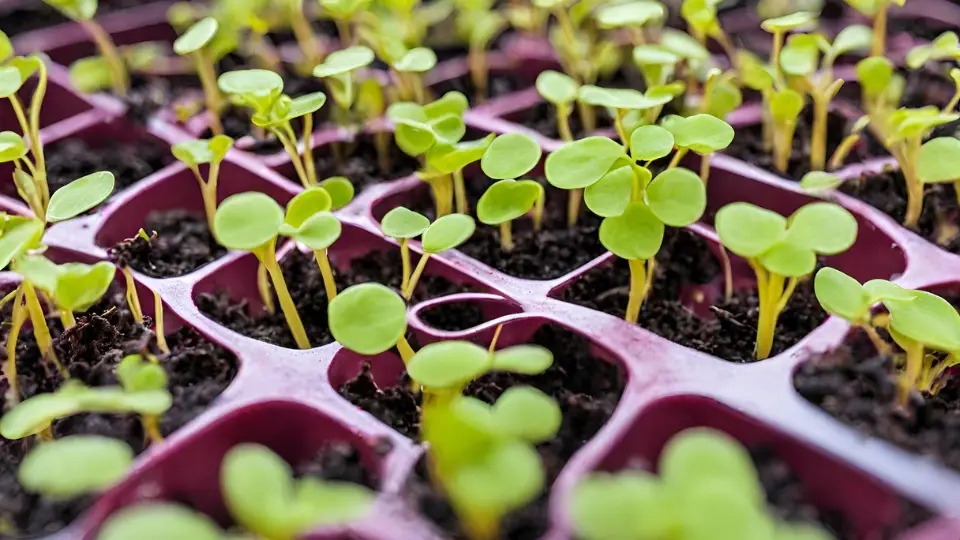
Cost-effective And Space-saving Option
If you are looking for an affordable and space-saving option to enjoy fresh and nutritious greens, planting mustard microgreens consistently is the way to go. Compared to fully-grown mustard plants, growing mustard microgreens requires minimal resources, making them a cost-effective choice for those on a budget.
Additionally, their fast-growing nature allows you to have a continuous supply of greens without taking up much space, making them an excellent choice for urban dwellers or those with limited gardening space.
With a small tray or container, a handful of mustard seeds, and a few basic supplies, you can grow an abundance of microgreens effortlessly. Investing a few minutes daily allows you to enjoy a bountiful harvest in one to two weeks. This cost-effective and space-saving option makes it accessible for anyone to cultivate fresh and nutritious mustard microgreens at home.
Quick And Easy To Grow
One of the most appealing aspects of growing mustard microgreens is the sheer simplicity and speed at which they sprout. Unlike traditional gardening, which can often be time-consuming and require extensive knowledge and experience, growing microgreens is beginner-friendly and convenient for those with busy schedules.
Just a few simple steps, and you’ll be on your way to a vibrant tray of mustard microgreens. Begin by soaking the seeds overnight to kickstart germination. Spread them evenly on a tray filled with a thin layer of soil or hydroponic medium.
Keep the growing environment humid and provide indirect sunlight. Within days, you’ll see tiny sprouts emerging, and within a week or two, you’ll have fully grown mustard microgreens ready for harvest.
By growing mustard microgreens, you bypass the long waiting periods associated with traditional gardening and have a fast turnaround time. This means you can witness your greens grow from seed to harvest in record time. Whether new to gardening or have an experienced green thumb, planting mustard microgreens is a quick and easy way to add nutrients to your meals.
Choosing The Right Mustard Microgreen Seeds
When it comes to growing mustard microgreens, choosing the right seeds can make all the difference in both fast growth and delicious flavor. This article will explore the highest-quality seed varieties for quick growth and exceptional taste and how to source high-quality seeds from reputable suppliers.
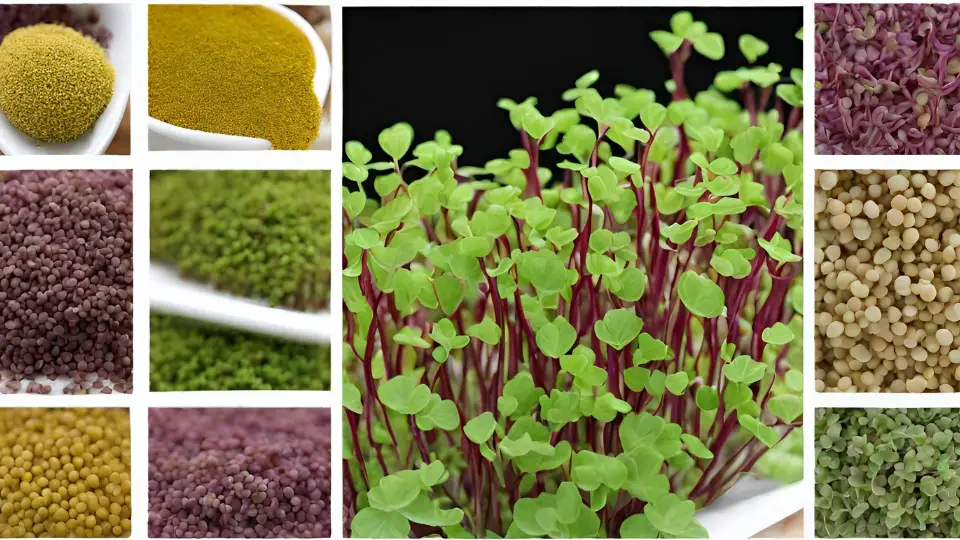
Best Seed Varieties For Fast Growth And Flavor
If you want to achieve fast growth and vibrant flavor in your mustard microgreens, selecting the right seed variety is crucial. Here are some of the top options:
| Seed Variety | Growth Rate | Flavor Profile |
|---|---|---|
| Black Mustard (Brassica nigra) | Rapid | Spicy and peppery |
| Red Giant Mustard (Brassica juncea) | Fast | Peppery with a hint of horseradish |
| Mizuna (Brassica rapa var. nipposinica) | Quick | Mild and slightly spicy |
These seed varieties are known for their quick germination and abundant growth, allowing you to enjoy fresh mustard microgreens in no time. Whether you prefer a bold and spicy kick or a milder flavor, there is a seed variety that suits your taste.
Sourcing High-quality Seeds From Reputable Suppliers
- Look for suppliers specializing in microgreen seeds, as they often have a wider selection and better quality control.
- Read customer reviews and ratings to gauge the reputation and reliability of the supplier.
- Verify that the seeds have been tested for germination rates and are guaranteed fresh.
- Consider buying organic seeds if you prioritize sustainability and organic growing practices.
- If possible, purchase seeds stored in temperature-controlled environments to maintain their viability.
By sourcing high-quality seeds from reputable suppliers, you can ensure that your mustard microgreens have the best chance of thriving. Remember to follow the specific growing instructions for each seed variety to optimize growth and flavor.
Preparing The Growing Medium
The growing medium is essential for successful mustard microgreen cultivation. It provides the necessary nutrients and support for microgreens to thrive and grow quickly. This section will discuss the different aspects of preparing the growing medium to ensure optimal growth and a bountiful harvest.
Selecting The Right Container And Tray For Optimal Growth
Choosing the right container and tray is critical in mustard microgreen growth. The container should be shallow with drainage holes to prevent waterlogging, which can lead to root rot. A plastic or ceramic container works well for this purpose.
A tray with effective drainage is equally important. The tray should be large enough to accommodate the container with some space around it. This allows proper air circulation and prevents mold and mildew.
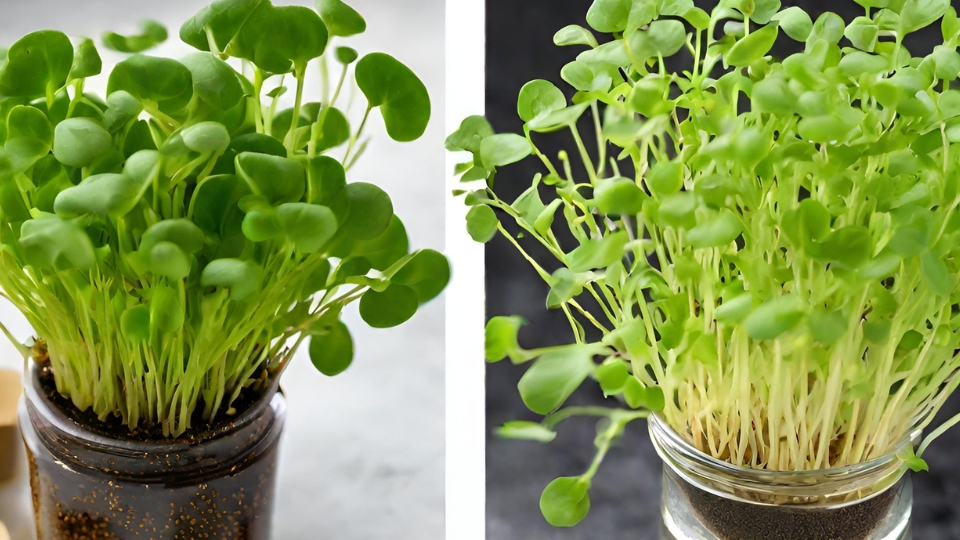
Choosing The Appropriate Soil Or Growing Medium
The soil or growing medium is the bed for mustard seeds to germinate and grow. It should be lightweight, well-drained, and nutrient-rich. Mustard microgreens are commonly produced with potting soil, cocoa coir, and perlite.
Potted soil provides the necessary nutrients, while cocoa coir helps with moisture retention and aeration. Perlite improves drainage and prevents soil compaction. Consider mixing these ingredients in equal parts to create a well-balanced growing medium.
Ensuring Proper Drainage And Moisture Retention
Proper drainage and moisture retention are crucial for mustard microgreens to thrive. Excessive water can lead to mold and bacterial growth, while inadequate moisture can cause microgreens to wither and struggle.
To ensure proper drainage, place a layer of small pebbles or gravel at the bottom of the container before adding the growing medium. This allows excess water to flow out of drainage holes, preventing waterlogging.
Regarding moisture retention, mist the growing medium with water before sowing mustard seeds. Avoid saturated soil, but ensure it is evenly moist. Use a spray bottle to mist the soil whenever it feels dry, ensuring it remains consistently moist throughout the growing process.
By selecting the right container and tray, choosing an appropriate soil or growing medium, and ensuring proper drainage and moisture retention, you can create an ideal growing environment for your mustard microgreens. The following section will discuss sowing the seeds and caring for the microgreens as they grow. Stay tuned!
Germination And Planting Process
The germination and planting process is crucial to growing mustard microgreens. By following the right techniques and providing optimal conditions, you can ensure fast and easy growth. This section will explore the step-by-step process for germinating and planting mustard microgreen seeds.
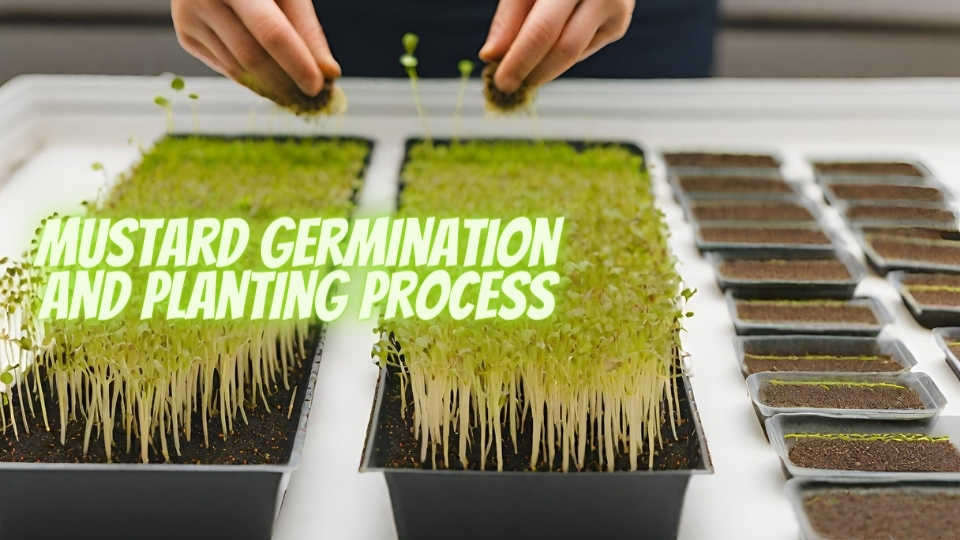
Soaking And Pre-treating Mustard Microgreen Seeds
To kickstart the germination process, it is recommended to soak and pre-treat your mustard microgreen seeds. This step helps to soften the seed coat and activate the germination process.
- Begin by measuring the desired amount of mustard microgreen seeds based on the size of your growing tray.
- Place the seeds in a clean container and add enough room-temperature water to cover them.
- Allow the seeds to soak for about 6 to 8 hours or overnight.
- After soaking, drain the water and rinse the seeds thoroughly to remove any residue or impurities.
- Next, pre-treat the seeds by gently rolling them in a damp paper towel or cloth.
- Cover the pre-treated seeds with the same cloth or paper towel and keep them in a warm, dark place for 24 to 48 hours.
Spreading Seeds Evenly On The Growing Medium
Even distribution of seeds on the growing medium is crucial for achieving uniform growth and ensuring all seeds have access to essential nutrients.
- Select a tray or container that provides adequate drainage.
- Fill the tray with a suitable growing medium, such as potting soil or coconut coir.
- Spread a thin, even layer of the growing medium across the tray.
- The pre-soaked and pre-treated mustard microgreen seeds are sprinkled evenly on the growing medium.
- Try to create a consistent spacing between the seeds to avoid overcrowding.
Covering The Seeds With A Thin Layer Of Soil Or Vermiculite
After spreading the seeds on the growing medium, it is important to cover them with a thin layer of soil or vermiculite. This layer helps to protect the seeds and provides a consistent moisture environment for germination.
- Take fine crumbly soil or vermiculite and gently spread it across the seeds.
- Ensure the layer covering the seeds is thin, around 1/8 to 1/4 inch thick.
- Lightly press down the soil or vermiculite to secure the seeds in place.
- Avoid applying excessive pressure to prevent seed damage.
Moistening The Soil And Providing Adequate Moisture Throughout The Germination Process
Proper moisture is vital for successful germination and continuous growth. Maintaining the right moisture level ensures the seeds receive the hydration they need to germinate and develop into healthy microgreens.
- Gently mist the soil with water until it is lightly moistened.
- Avoid excessive soaking or waterlogging, as it can hinder the germination process.
- Place a clear plastic cover or dome over the tray to create a humid environment for the seeds.
- Check the moisture levels regularly and mist the soil if it begins to dry out.
- Continue providing adequate moisture throughout germination, keeping the soil moist but not overly wet.
Caring For Mustard Microgreens
Proper care is essential for mustard microgreen growth. By providing the right conditions for lighting, watering, temperature, humidity, and pest prevention, you can ensure that your mustard microgreens flourish and develop their full flavor. Let’s explore each aspect of mustard microgreen care in detail:
Providing Proper Lighting Conditions
Mustard microgreens require adequate sunlight or artificial light to photosynthesize effectively. Placing them in bright, indirect light for 12 to 16 hours daily will promote growth. If natural light is limited, you may consider using low-intensity fluorescent or LED grow lights, hanging them 2 to 4 inches above the microgreens.
Watering The Microgreens And Maintaining Moisture Levels
Keeping the soil moist is crucial for mustard microgreens. Water them gently with a spray bottle or a watering can with a fine nozzle to avoid disturbing the delicate seedlings. Ensure the soil is moist, not soggy, by watering it lightly once or twice a day.
Adjusting Temperature And Humidity For Optimal Growth
Mustard microgreens thrive in temperatures between 60°F and 75°F (15°C to 24°C). Maintain a warm environment by using heating mats or placing them in a warm spot in your home.
Additionally, maintaining adequate humidity levels is essential, especially during germination. Covering the tray with a plastic lid or using a seedling heat mat with a humidity dome can help maintain the required moisture level.
Monitoring And Preventing Common Pests And Diseases
Monitoring your mustard microgreens regularly is essential to spot signs of common pests or diseases. Common pests affecting mustard microgreens include aphids, fungus gnats, and spider mites. You can prevent these pests by keeping the growing area clean and debris-free.
Additionally, practicing crop rotation and ensuring proper ventilation prevents diseases like damping-off. If you notice any signs of pests or diseases, you can use organic pest control measures like neem oil or insecticidal soap to address the issue promptly.
With proper care and attention to lighting, watering, temperature, humidity, and pest prevention, your mustard microgreens will grow fast and easily. You can enjoy nurturing these nutrient-packed greens from seed to harvest by providing the ideal conditions.
Harvesting And Storage
When it comes to growing mustard microgreens, harvesting, and proper storage play a crucial role in maintaining their freshness and quality. Identifying the ideal harvesting time, using the right techniques, and following proper storage practices can ensure that your mustard microgreens thrive and stay fresh for longer.
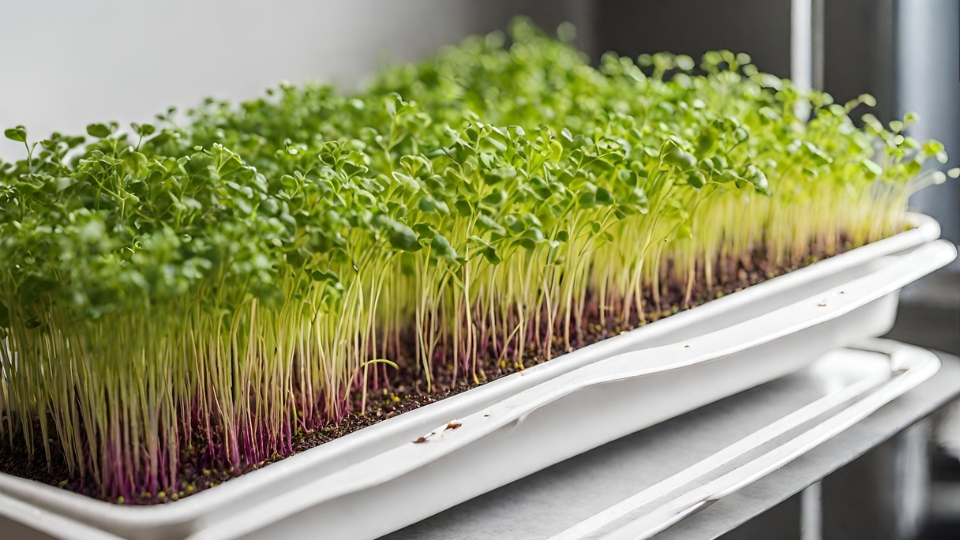
Identifying The Ideal Harvesting Time
Harvesting them at the right time is important to achieve the best flavor and nutrient richness in your mustard microgreens. Here are some indicators to help you identify the ideal harvesting time:
- The microgreens should have reached a height of about 2-3 inches.
- They should have developed their first set of true leaves.
- The leaves should be vibrant green and tender to the touch.
Harvesting at this stage ensures that the mustard microgreens are at their peak flavor and nutritional content.
Techniques For Harvesting Mustard Microgreens
Harvesting mustard microgreens can be done using simple techniques that allow for easy and efficient collection. Here are a few methods you can follow:
- Gently grasp a handful of microgreens close to the soil and use sharp scissors or a clean knife to trim them just above the soil level.
- If you prefer to harvest smaller portions, you can use your fingers to pinch off the microgreens just above the soil.
- Avoid pulling the microgreens forcibly, as this can uproot the entire plant.
Following these techniques, you can harvest your mustard microgreens without damaging the remaining plants, allowing for continuous growth and future harvests.
Proper Storage To Maintain Freshness And Quality
Proper storage techniques are crucial to extend the freshness and maintain the quality of your harvested mustard microgreens. Here are some essential steps to follow:
- Remove any wilted or damaged leaves from the harvested microgreens.
- Gently wash the microgreens under cold water to remove any dirt or debris.
- After thorough washing, allow the microgreens to air dry or use a salad spinner to remove excess moisture.
- Place the dried microgreens in a clean, breathable storage container. Use airtight containers, food-grade bags, or a paper towel-lined tray.
- Refrigerate the microgreens at a temperature between 35-40 degrees Fahrenheit.
By following these storage practices, you can prolong the shelf life of your mustard microgreens, ensuring they stay fresh and crisp for up to 7-10 days.
Frequently Asked Questions For How To Grow Mustard Microgreens Fast And Easy
How Do You Make Mustard Greens Grow Faster?
To make mustard greens grow faster, provide full sun exposure, well-draining soil, and consistent watering. Use organic compost or fertilizer to enrich the soil. Additionally, sow seeds directly into the ground, about 1/4 inch deep. With proper care and moisture, mustard greens will grow quickly and thrive.
How Long Does It Take To Grow Mustard Microgreens?
Mustard microgreens typically take around 7 to 10 days to grow.
How Do You Grow Mustard Seeds Fast?
To grow mustard seeds quickly, provide the right conditions: plant in well-drained soil, keep it moist but not overly watered, and expose it to full sunlight. Regularly add organic fertilizer to promote growth. Harvest the seeds when they turn yellow, and the pods start to dry.
How Long Does It Take For Mustard Microgreens To Grow?
Mustard microgreens typically take 7-10 days to grow from seed to harvest. However, the exact time can vary depending on temperature and sunlight exposure.
Conclusion
Growing mustard microgreens fast and easy is a rewarding and effortless process. By following these simple steps, you can ensure these nutritious greens’ rapid growth and abundance. Every aspect must be carefully considered, from selecting the right seeds to providing optimal growing conditions.
With patience and proper care, you can enjoy the fresh and flavorful mustard microgreens in no time. Start your indoor gardening journey today and experience the joy of growing your nutritious greens.
Video Source: https://www.youtube.com/watch?v=cuA0xnF8UgE

